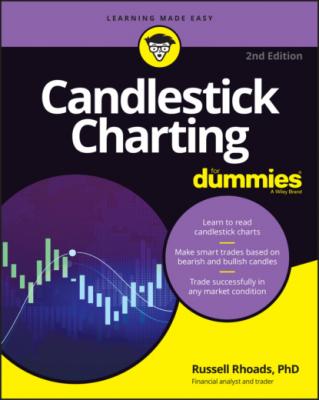ТОП просматриваемых книг сайта:
Candlestick Charting For Dummies. Russell Rhoads
Читать онлайн.Название Candlestick Charting For Dummies
Год выпуска 0
isbn 9781119869979
Автор произведения Russell Rhoads
Жанр Ценные бумаги, инвестиции
Издательство John Wiley & Sons Limited
Once again, a trader who studies candlestick charts and patterns can easily spot this change. Such a momentum shift is useful to someone who owns a security and is considering selling it or to a trader who has the ability to sell short. (See the sidebar above for more information.)
Admitting Potential Candlestick Charting Risks
After more than 25 years of using candlestick charts to inform my trading decisions, I can honestly say that I have a difficult time coming up with any substantial arguments for using other common types of charts.
They don’t work in the very short term. Candlestick charts are an excellent way to display price action, but for some extremely short-term trading strategies, such as holding for a matter of minutes, the patterns that reveal themselves on a daily candlestick chart may not develop on a much shorter time frame — fewer than 5 minutes, for example.I like to think of candlestick charts as being visual representations of the battle between the bulls and bears, which is played out in the price action of a stock. That battle takes some time to play out, so patterns on a very short-term chart may not produce signals that can be interpreted properly and traded on.Candlesticks aren’t as useful in intraday “scalping” (buying or selling in a matter of seconds) or day-trading strategies in which hold periods are generally shorter. Candlesticks are a bit more useful for periods where behavior is developing over time versus the reactionary trading of day traders.
They don’t reflect trade volume outside regular market hours. The advent of increased electronic trading means that significant volume is sometimes traded outside regular market hours. This trading can cause patterns that keep the full picture from appearing on a candlestick chart.If a stock officially opened at 9:30 a.m. at a price of $50 but traded as low as $49 during the premarket hours (on an electronic trading network), the open may not be a true reflection of where the stock initially traded on the day. As a result, the open recorded on the candlestick is somewhat inaccurate. Also, if the stock never trades down to $49 during the day, the low on the chart may not be an accurate depiction of the day’s price action.
Comparing Candlestick Charts with Alternative Charting Methods
Knowing a bit about alternatives to candlestick charts serves as a point of reference and makes clear the benefits of using candlestick charts for analyzing price data.
Line charts are simple and straightforward.
Bar charts are important to understand because they’re still relatively prevalent and often the default setting in a charting package.
Point and figure charts are great for revealing support and resistance levels.
I’m confident that you’ll be a believer in candlesticks when everything is said and done, but understanding the alternatives is certainly worth your time.
Line charts
A line chart is a line on a chart that displays security prices over time. A line chart represents the price — usually, the closing price — of a security from one period to the next.
Figure 2-5 is a line chart showing three months of daily closing prices for a stock.
FIGURE 2-5: A line chart.
Bar charts
A traditional bar chart contains bars that represent price action from period to period. Each bar is a vertical line that shows the difference between the high and the low of the period. The top of the bar is the high, and the bottom is the low. The distance between the top and bottom is similar to the wick of a candle on a candlestick chart. (The wick is discussed more in Chapter 1.) The finishing touch on a bar chart is a little notch on the right of the bar that’s made to mark where the security closed. Figure 2-6 shows a single bar taken from a bar chart.
Figure 2-7 is a chart of the same data that appeared in the line chart in Figure 2-5.
Bar charts have been the industry standard for some time but are quickly being replaced by candlestick charts. When The Wall Street Journal starts using a new charting convention (as it has with candlestick charts), the convention is considered to be the industry standard.
FIGURE 2-6: A single bar from a bar chart.
FIGURE 2-7: A run-of-the-mill bar chart.
Point and figure charts
Point and figure charting is another type of stock charting that’s been around for so long that it deserves a mention. A point and figure chart is composed of Xs and Os drawn on a sheet of graph paper. This chart isn’t constructed with a set time frame; instead, it’s based on reversals of price. The Xs make up a series of up moves without a certain price reversal, and the Os represent a series of down moves without a price reversal.
Figure 2-8 is a point and figure depiction of the same data that composes the line and bar charts in Figures 2-5 through 2-7. The figure values each square with one point and adds a new column with a change of direction of at least two points, based on the close. If day one has a closing price of 75, and day two has a closing price of 78, you draw Xs from 75 to 78. If on day three, the closing price is 76 (a 2-point reversal), a new column is added, and Os are placed in the 77 and 76 squares. If the price stays in the 76 to 77 range for a few days, no changes are made to the chart.
FIGURE 2-8: A point and figure chart.

